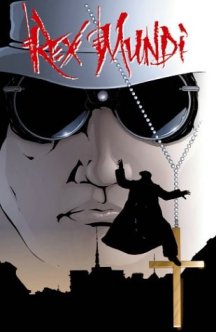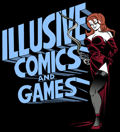| Rex
Mundi: Guardian of the Temple
 Through
some very odd literary coincidence, my pleasure reading and
my school reading have always collided in some way. The comics
and novels I read almost always relate to something I happen
to be studying in college. When taking a Mystic Writers survey,
I started reading Alan Moore's Promethea; when taking
Post-Civil War history I was reading Harry Turtledove's Guns
of the South (an alternate history book where the Confederates
had AK-47s). Intermediate French? I was reading Metabarons,
followed by The Incal. You could probably guess my
course load based solely on what I pick up at Borders or my
local comic shop every Wednesday. Through
some very odd literary coincidence, my pleasure reading and
my school reading have always collided in some way. The comics
and novels I read almost always relate to something I happen
to be studying in college. When taking a Mystic Writers survey,
I started reading Alan Moore's Promethea; when taking
Post-Civil War history I was reading Harry Turtledove's Guns
of the South (an alternate history book where the Confederates
had AK-47s). Intermediate French? I was reading Metabarons,
followed by The Incal. You could probably guess my
course load based solely on what I pick up at Borders or my
local comic shop every Wednesday.
So I was
not unduly surprised when I cracked open the first volume
of Rex Mundi, and found that all those little history
tidbits, fallen from my Global History of the 20th Century
textbook and into my brain, suddenly applied to something
other than a multiple choice test.
Rex
Mundi is a true mystery comic with undertones of horror
and fantasy, set in a world faintly different from our own.
In France of 1933, the Catholic Church still holds power over
the citizenry and the monarchy of France continues to rule
as the French Revolution was put down after the aristocracy
consolidated its forces and crushed the rebellion. Magic is
real but seen as a path to the devil and only the Sorcerer's
Guild can practice it without recrimination and without church
sanction. The Holy Roman Empire sits where once the Austrian-Hungarian
Empire occupied, and the United States is separated into the
National Republic of America and the Confederate States of
America.
In this
familiar yet wrong world, Dr. Julien Sauniere is asked by
his friend Father Marin to investigate the theft of a medieval
scroll stolen from a secret crypt in a Parisian church. Marin
asks only out of desperation, as no one outside of the highest
echelon of the Catholic Church is supposed to know of the
scrolls' existence, and Sauniere obliges his friend. What
he finds is a series of grisly murders with ritualistic elements,
what could possibly be a conspiracy against the monarch Louis
XXII, and an ancient secret society all somehow connected
to the missing scroll.
There
are two story elements that are simply spectacular, the first
being the excellent world-building that writer (and apparently
letterer and layout artist) Arvid Nelson pulls off. Alternate
histories are hard to write, as they require in-depth research
so as to appear plausible. It's much easier to simply create
a world for your characters to inhabit, a trick CrossGen figured
out long ago in their comic line, than it is to use your knowledge
of history to craft a truly believable alternate reality.
Nelson
does it in spades; so much so that he doesn't need to explain
it at any great length to the reader. The reader naturally
picks it up as the story moves along. The Inquisition, the
Catholic police force, seamlessly replaces a conventional
law enforcement agency, as they investigate crime scenes and
question suspects, despite the fact that they walk around
in metal face masks and wear armor underneath brown robes.
The aristocratic government divided into the Hall of Robes
and the Hall of Swords is a nice touch and one can see Nelson's
eye for political structure, creating these branches under
the king, yet at times, in opposition to him. Nelson sets
up the economic structure of his created world also, in the
creation of the various guilds: the Guild of Illuminists,
the Guild of Physicians, the Guild of Railway Workers, etc.
It's such a common sense idea to place these institutions
in the script, as it echoes the real history of the beginnings
of labor unions and collective bargaining in both America
and Europe, yet Nelson manages to make it his own plot device
that will tie later to the over all mystery of the piece.
Helping
to explain the various cultural aspects of Nelson's alternate
reality are the chapter breaks in the graphic novel. Between
each chapter is a fake newspaper front-page from Le Journal
de la Liberte, as well as a back-up piece that pertains to
the happenings of the plot. It provides the reader with the
history and current events of the world the comic is set in
while still providing clues to the over-arching design Nelson
has in mind. Especially interesting is Nelson's explanation
of how and why magic works in this world.
The second
story element is the depth of the mystery involved with this
lost scroll. Mystery is becoming more and more common in comics
today, but too often the so-called mysteries are so full of
red herrings as to be annoying, or too simplistic to challenge
the reader. Nelson has created a mystery that began simple
(find the missing scroll) and has become infinitely complex.
Every
time Dr. Sauniere uncovers a new clue as to the whereabouts
of the scroll, the puzzle becomes more intricate and the reader
is pulled farther into the back alleys of France and the catacombs
of the Catholic Church surrounding the story. The reader has
no idea where the story is going, but the reader knows that
it's going somewhere, which enables him or her to sit back
and enjoy the intricacy of the script, as well as the fairly
large cast of major and minor characters in the narrative.
EricJ
is the artist for the title and he's extremely good. His pacing,
coupled with Nelson's layout of the storyline, is wonderful,
demonstrated most notably in the several instances where entire
pages go by without a word balloon between them. EricJ knows
that too many talking-head-panels in a mystery makes it boring
and he allows the visual to either creep-ify or thrill the
reader where suspense is called for; his silent panels are
some of the best scenes in the comic and the most telling
as it concerns the search for the scroll. He also has a spectacular
knack for period drawing and a wonderful concept of architecture.
The buildings along the Rue Duphont are beautiful, and his
many shots of French landmarks are quite good; the prime example
being his rendition of Notre Dame on the cover of the volume.
His character work is great and so is eye for the kinesthetic
of his characters.
The only
problem I see in his artwork is that he tends to lay the inks
on too heavily in the beginning of the book, obscuring good
line work making black holes in the visuals, but this corrects
near the end of the book, so future volumes will most likely
be better. Also, Jeremy Cox (Leave
It To Chance, Starman)
is the colorist. He is the best colorist in the business right
now and I need say nothing more.
Rex
Mundi is a rare book and I applaud the hell out of Image
Comics for being able to promote and sell a book that has
such an out of the ordinary concept, something Marvel has
rarely been able to do, and DC sometimes has trouble with.
It's possessed of a fierce intelligence that doesn't pressure
to the reader, but slowly moves him or her along the narrative,
drawing them deeper into the story after each page. It's just
plain beautiful and you should abscond with $14.95 to whatever
print media distribution center you can get to and buy the
damn thing. Order it if you have to, because it's one of the
best comics in the last couple of years.
Rex
Mundi: Guardian of the Temple
|
 Through
some very odd literary coincidence, my pleasure reading and
my school reading have always collided in some way. The comics
and novels I read almost always relate to something I happen
to be studying in college. When taking a Mystic Writers survey,
I started reading Alan Moore's Promethea; when taking
Post-Civil War history I was reading Harry Turtledove's Guns
of the South (an alternate history book where the Confederates
had AK-47s). Intermediate French? I was reading
Through
some very odd literary coincidence, my pleasure reading and
my school reading have always collided in some way. The comics
and novels I read almost always relate to something I happen
to be studying in college. When taking a Mystic Writers survey,
I started reading Alan Moore's Promethea; when taking
Post-Civil War history I was reading Harry Turtledove's Guns
of the South (an alternate history book where the Confederates
had AK-47s). Intermediate French? I was reading 




